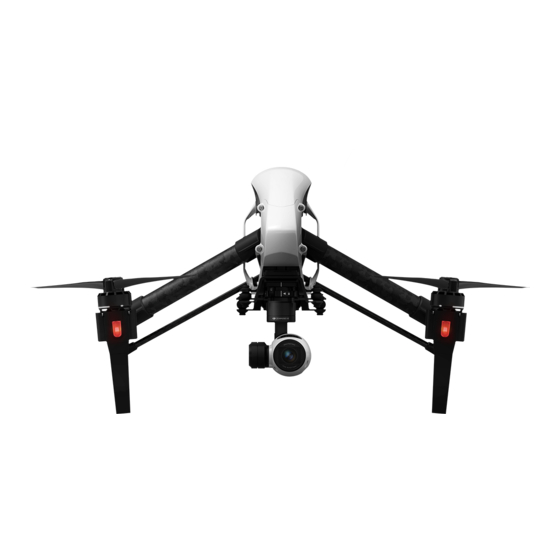dji Inspire 1 빠른 시작 매뉴얼 - 페이지 4
{카테고리_이름} dji Inspire 1에 대한 빠른 시작 매뉴얼을 온라인으로 검색하거나 PDF를 다운로드하세요. dji Inspire 1 10 페이지.
dji Inspire 1에 대해서도 마찬가지입니다: 빠른 시작 매뉴얼 (11 페이지), 사용자 설명서 (20 페이지)

Fly Safe
DJI encourages you to enjoy flying in a safe, responsible and smart way.
DO NOT FLY
near or above people, near
trees, power lines or buildings.
DO NOT FLY
in rain, snow, fog, and wind
speeds exceeding 22 mph or 10 m/s.
Be very careful when flying 14,700 feet (4,500 meters) or more above sea level as the battery and aircraft performance may be reduced.
●
The Inspire 1's compass and GPS will not work in Polar Regions. The aircraft will auto switch to ATTI Mode and use the VPS for positioning.
●
Calibrating the Compass:
●
Make sure to calibrate the compass in every new flight location. The compass is very sensitive to electromagnetic interference,
which can cause abnormal compass data leading to poor flight performance or even failure. Regular calibration is required for
optimum performance.
DO NOT calibrate your compass where there is a chance of strong magnetic interference, such as magnetite, parking
●
structures, and steel reinforcements underground.
DO NOT carry ferromagnetic materials with you during calibration such as keys or cellular phones.
●
DO NOT calibrate beside massive metal objects.
●
If it is blinking red and yellow alternately after placing the aircraft on the ground, the compass has detected magnetic
●
interference. Change your location.
P Mode:
●
In this mode, the Inspire 1 has a strong GPS signal and can use the
VPS allowing it to hover accurately in position indoors and out. If
outdoors, this mode also means that a Home Point has been
locked so that it can Return to Home if the control signal is lost.
If you are not in this mode, toggle the Flight Mode
Switch to P position to enable it.
The Flight Mode Switch is locked in P mode by default.
Refer to the User Manual on how to unlock the switch.
There are three states in P mode.
P-GPS: GPS works best when outdoors in a wide open area, and
your Inspire 1 uses GPS to hover in place when the GPS signal is
strong. P-OPTI: If GPS is not available, the aircraft can use the
VPS to hover accurately. P-ATTI: Neither GPS or VPS available,
aircraft is using only its barometer for positioning, so only altitude
is controlled. Note that the VPS may not work properly when the
Inspire 1 is flying over water, over surfaces without a clear pattern,
or in a low light environment.
While returning home, its altitude can be adjusted by the user to avoid obstructions. Tall buildings may affect the remote controller signal. The
●
Failsafe Return to Home procedure will be triggered if the signal is lost. Be sure fly higher than any nearby buildings to avoid crashing.
400 ft
Always
fly under
DO MONITOR YOUR ALTITUDE
and fly under 400 feet
(120 meters).
DO MAINTAIN LINE OF SIGHT
and avoid flying behind buildings
or obstacles that block your view.
Return to home
It is important to understand basic
flight guidelines, for the safety of
both you and those around you.
Refer to the Safety Guidelines and
Disclaimer for more information.
More information at:
http://flysafe.dji.com/no-fly
GPS Positioning
Return to Home:
●
When the GPS signal is strong, the aircraft will be
able to record a Home Point and return to the Home
Point when needed. The GPS location is recorded
when the GPS signal icon in the DJI GO app is either
yellow or green.
The aircraft will return to the Home Point automatically in
the following cases (all require a strong GPS signal).
Smart RTH: When you press the RTH button on the
remote controller or in the App. Low Battery RTH: The
DJI GO app notifies users to take action when the
battery level falls to a specified threshold.
Failsafe RTH: When the remote controller signal is lost.
No Fly Zones
Vision Positioning
Altitude 3 m
